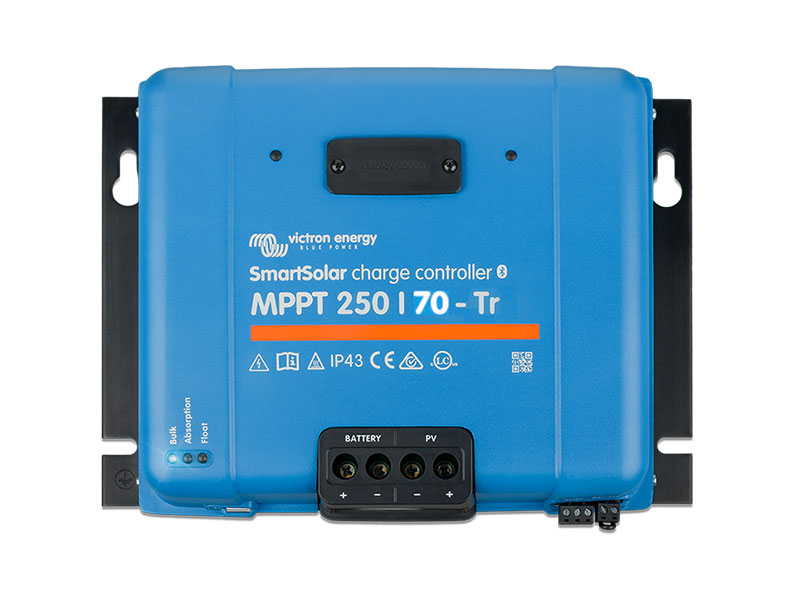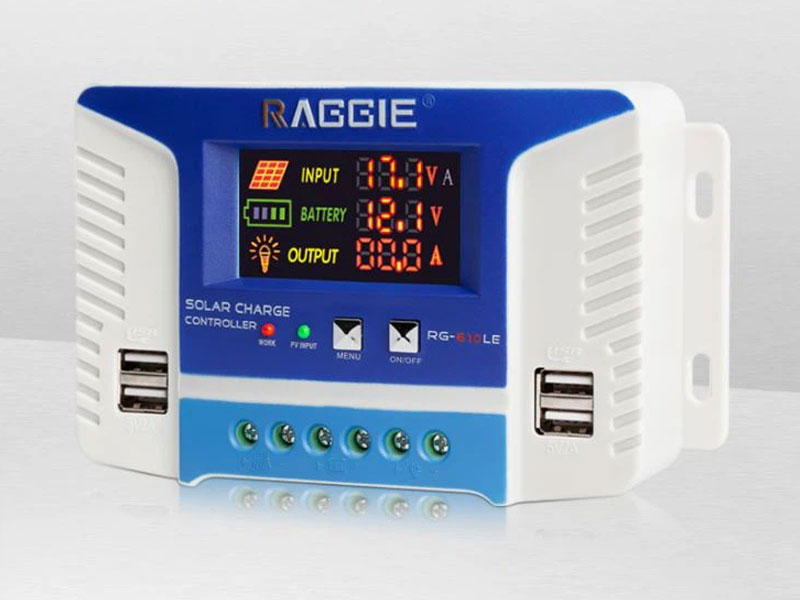Solar charge controllers




MPPT charge controllers
Solar panel arrays which are used to charge batteries require a charge controller. A charge controller regulates the DC power coming from the solar panels to the battery storage bank. Also, a charge controller is very effective to increase the lifespan of the batteries. There are three types of charge controllers available for solar applications namely: Pulse width modulation controller, simple on-off charge controller, and a maximum power point tracking charge controller. Maximum Power Point Tracking (MPPT) charge controllers are a type of electronic device used in solar power systems to optimize the efficiency of energy harvesting from solar panels. MPPT charge controllers are designed to maximize the power output of solar panels by continuously tracking and adjusting the operating point, or maximum power point (MPP), of the panels’ voltage and current characteristics. This helps ensure that the solar panels are operating at their highest possible efficiency and generating the most electricity.
Here’s how MPPT charge controllers work:
How MPPT Charge Controllers Work:
- Voltage and Current Characteristics: Solar panels have a voltage-current curve that describes their performance based on the amount of sunlight they receive. The maximum power point (MPP) is the point on this curve where the panels generate the most power.
- Variable Operating Conditions: Factors such as temperature, shading, and the angle of sunlight can cause the operating point of the solar panels to shift along the voltage-current curve.
- Optimization: MPPT charge controllers use sophisticated algorithms to continuously track and adjust the operating point of the solar panels to ensure they are operating at or near their maximum power point.
- DC-to-DC Conversion: MPPT controllers also convert the direct current (DC) output of the solar panels into the appropriate voltage and current needed to charge the batteries. This conversion is more efficient than the traditional “PWM” (Pulse-Width Modulation) charge controllers.
Benefits of MPPT Charge Controllers:
- Increased Efficiency: MPPT charge controllers can improve the overall energy harvest of a solar system by up to 30% compared to non-MPPT controllers. This is especially significant in low-light or partially shaded conditions.
- Flexibility: MPPT controllers can accommodate higher voltage solar panels and convert them to the appropriate voltage for battery charging, allowing for more flexibility in system design.
- Better Utilization of Panels: MPPT technology enables solar panels to operate at their highest efficiency even when environmental conditions change.
- Compatibility with Various Battery Types: MPPT controllers are suitable for various battery types, including lead-acid, lithium-ion, and other types commonly used in solar installations.
- Battery Charging Profile: MPPT controllers can adapt their charging profile based on the state of charge and temperature of the batteries, optimizing battery health and lifespan.
- Remote Monitoring: Some MPPT charge controllers come with monitoring features that allow users to remotely monitor the system’s performance and adjust settings as needed.
It’s important to select an MPPT charge controller that is compatible with the specifications of your solar panels, battery bank, and system configuration. Consult with solar professionals or refer to the manufacturer’s recommendations to ensure you choose the right MPPT charge controller for your specific setup.
Solar panels produce a much higher voltage to charge batteries in the battery bank. Most batteries are configured in 12V, 24V or 48V. A 12V panel for charging will produce 16 to 18 volts which is more than a 12V battery requires. Only 14.6V is required to charge a 12V battery. This is where the MPPT controller comes in. The MPPT charge controller converts the extra volts into more current which can be used to charge the batteries in a quicker and faster rate. Thus, making the system much more efficient.
MPPT charge controllers can accommodate for much higher voltage setups from solar arrays. Therefore, voltage drop and line losses are decreased. So, you can basically add more solar panels into series. Thus, increasing the input voltage which would allow you to implement smaller wires. Also, the distances between panels and charge controllers can also be larger due to MPPT charge controllers.
Using maximum power point tracking charge controllers, you can implement much larger solar panel arrays than you would normally have with PWM charge controllers.
In grid-tied solar configuration systems, a MPPT charge controller is the only device which can handle the higher voltages. To use your grid-tied solar solution and you want to make use of battery storage, a MPPT charge controller is the correct device for your needs.
MPPT charge controllers are 94% to 99% efficient. Thus, they are more than 30% efficient compared to PWM charge controllers.
MPPT charge controllers are a new technology which is widely adapted around the world. With all the benefits we get from MPPT charge controllers, the downside is, MPPT controllers are expensive.
However, MPPT charge controllers are an excellent solution in situations where solar panels might struggle to generate electricity, such as cloudy days or cold winter times. MPPT charge controllers can extract all the solar energy that is available to charge the batteries.
Beware as there are many MPPT controllers that are cheap products and can not live up to standards. Always ensure to do your research into MPPT manufacturers and products before you buy the very affordable MPPT charge controllers.

PWM charge controller
Pulse width modulation controllers or PWM charge controllers are more efficient when charging the batteries compared to simple on-off controllers. PWM controllers will taper the voltage down as the battery charges to maximum capacity. If the battery is fully charged, the PWM charge controller switches to a float charging profile which allows a trickle current to keep the battery in a charged state. PWM charge controllers are more efficient in prolonging battery life than simple on-off charge controllers.




On-off charge controllers
On-off charge controllers work very simplistically. These charge controllers determine and detect the voltage of the batteries and switch on or off the power.

